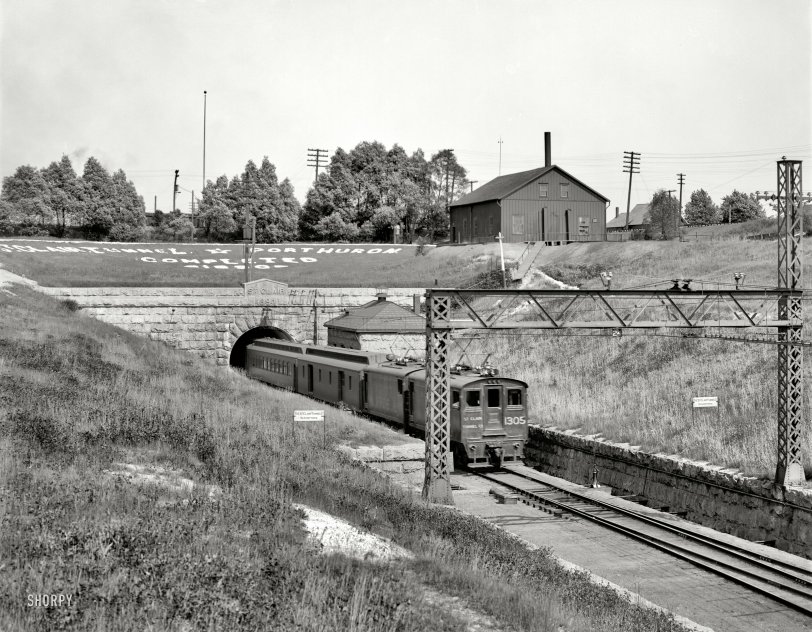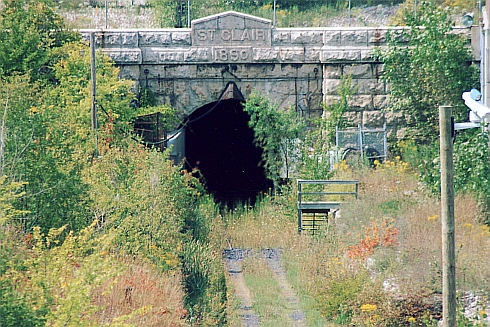


Framed or unframed, desk size to sofa size, printed by us in Arizona and Alabama since 2007. Explore now.
Shorpy is funded by you. Patreon contributors get an ad-free experience.
Learn more.

- Heckuva remote control!
- Sometimes — Things Go Bump!
- I SEE THE LIGHT
- Union Switch and Signal Company
- Get That Light Out Of My Eyes
- Eggs. Eggs. Eggs. The Egg Man is Here!
- Foreboding caption
- Famous Hollywood faces
- Not just S&P
- re: Those things in the jar
- Up In Smoke
- Medical Smoking
- Quick fix
- A Quink Comment
- If You’re Like Me, Never
- Delivering the News
- U.S.A.
- S&P
- 1940 Zenith radio model 6G601
- Quality goes in before the name goes on!
- Snazzy skirt
- Carbon Arc Lamps
- Illuminate us
- I remember it well
- I can't prove it
- Complicated then, forgotten now
- Bryan-Stevenson
- Skinny is as skinny does
- How do you rest in peace
- Riding the footboards
Print Emporium
St. Clair Tunnel: 1905

Port Huron, Michigan, circa 1905. "St. Clair Tunnel." Oh, and please note: "No Admittance." 8x10 inch glass negative, Detroit Publishing Co. View full size.
First
The St. Clair Tunnel was the world's first underwater tunnel between two nations. The Michigan Central Tunnel between Detroit and Windsor was the second and the Detroit-Windsor automobile tunnel was third.
St. Clair River Tunnel
The Railroad and Engineering Journal, Volume 62, 1888.The St. Clair River Tunnel. — After a long period of waiting, work on the proposed tunnel under the St. Clair at Port Huron is again actively under way. The developments so far are most satisfactory, the measurement showing more than the required thickness of clay everywhere, with no fault or break discoverable. The shoe on the American side was successfully put in place recently, and the shaft is now being excavated.
On the Canadian side good progress is being made, and the brick lining has been lowered by successive drops of from 4 to 8 ft. each, until it is now half way or so to bed-rock. A blower for forcing air down the shaft and the electric light plant of the machinery will soon be in place.
The tunnel is to be built by a separate company, but will be used by the Grand Trunk Railway trains.
Encyclopædia Britannica, 1891.River Tunnels. — Small tunnels under navigable streams are quite frequent in the United States. In Chicago a number have been bored under the Chicago River in order to connect the several parts of the city without bridges. The project of a tunnel under the Detroit River, through which railroad traffic should be carried without interfering with navigation, has long been discussed. Various towns have, from time to time, been selected as sites for the beginning of operations. At Port Huron, some miles above Detroit, the River St. Clair is now being tunnelled in order to avoid the carrying of cars upon railroad ferry-boats. When completed, the tunnel will shorten the distance between Buffalo and the cities of Detroit and Chicago. It will be over a mile in length, 2310 feet being under the river, 1810 feet under dry ground south of the city limits of Port Huron, and 1160 feet on the Canadian side; 1500 feet of the portion under the river will be almost level, falling eastward only enough to cause the water that leaks into the tunnel to run to the Canadian side. The total length of the ascent on the American side will be 4900 feet, and on the Canadian side 4970 feet. The length of the open cutting or approach at the Port Huron end of the tunnel will be 2820 feet, and at the Canadian end 3270 feet. The depth of the lowest part of the tunnel below the surface of the water will be 81 feet, which is 15 feet higher than had been at first expected, on account of anticipated quicksands and water-pockets. The minimum depth of the top below the bed of the river will be 15 feet. The tunnel has a clear internal diameter of 20 feet, and is intended for a single track. A double-track tunnel was at first proposed, but it was found that two single-track tunnels could be built at less expense than one doubletrack. Should this tunnel prove successful and profitable, the company intends to build a second one. The cost of the tunnel is estimated at $1,500,000.
Souvenir History of Port Huron, Michigan, 1906.… the most notable and absorbing sight are the great St. Clair Tunnel engines, which were built expressly for taking heavily loaded trains through the great underground international railway thoroughfare. You enter a well-appointed car and take a seat the bell rings, and the great train soon begins to trundle away toward the approach to the largest submarine tunnel in the world. Broad banks of blue clay rise on each side, abutted with heavy stone masonry. The train increases its speed, and if you can get near the rear car door of the last coach when the train plunges into the tunnel and a moment after daylight is changed for darkness, the opening which you have entered as it recedes looks like a beautiful landscape placque hung upon a wall of inky darkness. The train thunders on, and in less time than you can describe the trip the express commences to climb the grade on the Canadian side and has stopped at the Sarnia depot, and you have ridden through a tunnel measuring 6,025 feet from portal to portal. and under the greatest water highway of the world.
The lawn lettering
To be viewed by passengers on the other rail alignment, visible to the upper right.
Hey, Sleepy!
Welcome to Shorpy. But wake up and pay attention. In particular r-e-a-d the captions. Dave let you off light. This time.
Sometimes a tunnel is just a tunnel.
Sir Alfred Hitchcock liked these shots bunches! And he used them too.
See the movie
Go to the following link to see an Edison-Biograph film made between 1896 and about 1905:
http://www.youtube.com/watch?v=EQzXCoQRbas
At 4:01-4:51 the camera is mounted on the front of a locomotive going through St. Clair Tunnel. The film was made before the above photo, because the railroad is not yet electrified. [You actually go through the entire tunnel; the film negative is reversed to see the interior of the bore.]
The rest of film is full of some neat eastern railroading too. Sort of like seeing some of Dave's old photos starting to move...
Life imitates art
This makes me think of Alfred Hitchcock.
Long and Lasting
This tunnel was over 6000 feet long and was in use from 1891 through 1994. It was replaced by a tunnel with the same name in 1995.
Sometimes a Tunnel is just a Tunnel
Could this BE more Freudian?
102 years later
This is how it looked in September 2007.

Advertising
Could it be that the lettering on the lawn is an early form of advertising to be seen from the air?
[I don't think so. - Dave]
Who do you believe?
Interesting discrepancy. The year of this photo is 1905 but some detailed historical research indicates that electric trains didn't start running until 1908. The contract to electrify the tunnel wasn't awarded to Westinghouse until 1906.
http://loc.gov/pictures/item/mi0363/
(relevant bit about electrifying the tunnel is on page 32 of the report. Click the Data Pages link)
[The "year of the photo" is not 1905 but, as noted in the caption, "circa 1905." Meaning around, in the general vicinity of. - Dave]
The first one !
According to Wikipedia, electrification of the St.Clair tunnel was completed in 1908. Maybe some astute railfan could verify this? Also this was the first full-sized underwater railroad tunnel built.
Tempting
Yeah, fer sure, I wanna be in that tunnel when a train comes through. Not likely!
Signaled block system
Doing just a little research, I discovered traffic through the tunnel was controlled by a signaled block system. The train dispatcher shared quarters with the block system equipment on the Sarnia side, and the building in the picture housed the equipment on the Port Huron side. It appears to be that the switch was an early dual control, subject to remote operation by a control operator, and also to hand operation by train crews as circumstances warranted. Great snippet of railroad history.
























On Shorpy:
Today’s Top 5